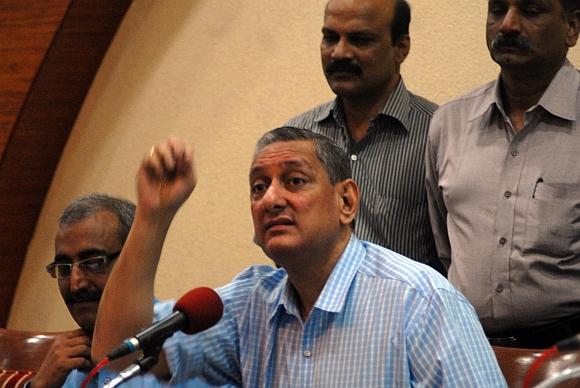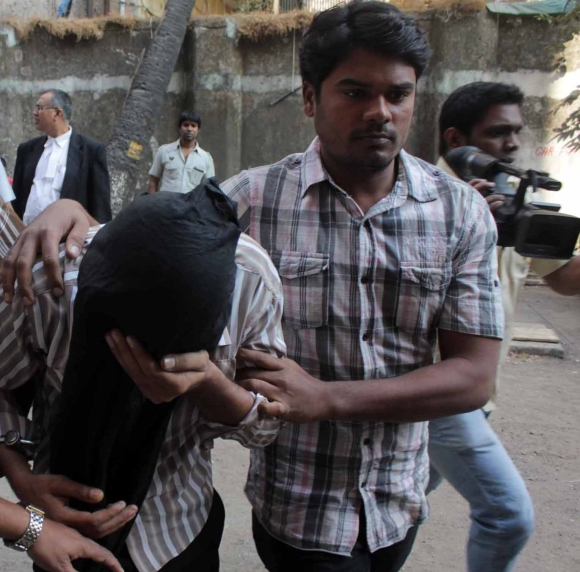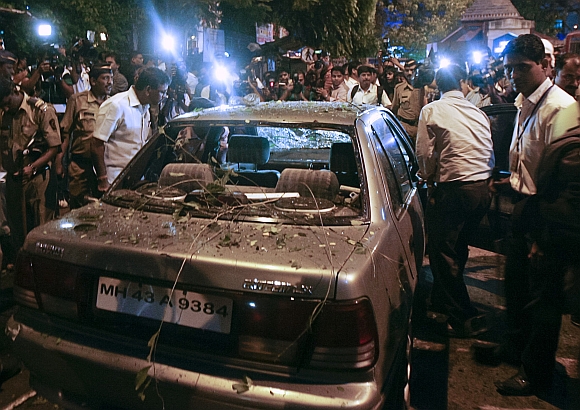 | « Back to article | Print this article |
13/7 Mumbai blasts case breakthrough, two arrested from Bihar
The Maharashtra Anti-Terrorism Squad on Monday claimed to have made a major breakthrough in the July 13 triple blasts in Mumbai last year that claimed 27 lives, with the arrest of two of the accused hailing from Bihar.
Naqi Ahmed Wasi Ahmed Sheikh, 22, and Nadeem Akhtar Ashfaq Sheikh, 23, were arrested on January 12 but the mastermind of the crime Yasin Bhatkal, a top Indian Mujahideen operative, and the planters of the Improvised Explosive Devices used in the blasts are still evading arrest, ATS chief Rakesh Maria told the media.
Maria said while Naqi came to Mumbai in September 2010, Nadeem, his co-villager, from Bihar's Darbhanga district, was living in Antop Hill area of the city.
Naqi, according to Maria, came in touch with Ahmed Zarar Siddibappa alias Yasin Bhatkal alias Imran in 2008. He said Nadeem was called to Delhi by Bhatkal and handed over a cloth packet containing the explosive and detonators used in the blast that was handed over to Naqi.
Naqi, he said, was given Rs 1.5 lakh by Bhatkal as commission for the crime in which at least Rs 10 lakh, received through hawala channels, was used. He said Naqi and Nadeem had stolen two Activa scooters that were used for carrying out the explosions. Two motorcycles also stolen by them and kept for future use have also been recovered from Bihar.
With inputs from PTI
Click NEXT to read further...
13/7 Mumbai blasts breakthrough, two arrested from Bihar
Rubbishing media reports that Naqi was innocent and that he was being tortured in police custody, Maria said he was aware of Bhatkal antecedents.
Naqi not only assisted Bhatkal in scouting for an apartment in Habib Building in Byculla (in south Mumbai) but also paid the money for accommodation, the ATS chief said.
Maria said while Bhatkal and two others, who had planted the explosives and whose names he refused to divulge lest it would hamper investigations, were eluding the police dragnet, another accused in the case --Haroon Rashid Naik -- had already been arrested by the ATS in a counterfeit currency case.
Naik, he said, had been arrested in August last year and the ATS would on Monday seek a transfer warrant for him from the court. "We need the custody of Naik from Mumbra for investigation of economic trail and conspiracy in the case," he said.
Maria trashed media reports that Bhatkal was in the city for several months after the blasts and that he was to visit the landlady of the Byculla apartment when he got the whiff of impending action by the Mumbai police due to lack of coordination between Delhi police's special cell and the Maharashtra ATS and escaped. "Bhatkal was in the city in June and for some time in July. He left on July 13 and did not come back," he said.
13/7 Mumbai blasts breakthrough, two arrested from Bihar
The ATS chief said several articles including computer and clothes of the inmates of the Byculla room have been seized for forensic examination. "We have asked for a forensic analysis of the room as we believe that the IEDs used for the blasts were assembled in the room," he said.
Maria said 40 officers and over 100 men of the ATS had visited 18 states as part of the ongoing investigation and examined 12,373 witnesses.
The ATS chief also junked reports about any tiff or lack of coordination with Delhi police in carrying out the probe, saying investigators from Mumbai were getting all cooperation from their Delhi counterparts.
"Competition is good and it should be there. Which police will not want to crack the case, but there is no rivalry," he said.
Maria said he would have liked to go to the media only after wrapping up the investigation but decided to hold the press conference owing to "speculative reporting and rumour mongering".
The information gathered by the ATS and the investigation carried out by the Delhi police points out that Bhatkal not only masterminded the 13/7 attacks but also synchronised the blasts at Bengaluru's Chinnaswamy Stadium in April 2010 and the Jama Masjid in September the same year.
13/7 Mumbai blasts breakthrough, two arrested from Bihar
Apart from the involvement of Bhatkal, the common factor in these three cases is the hand of the Bihar module. Clearly, the Indian Mujahideen appears to have resurrected itself using the Bihar module.
When the Delhi police made the first arrests in Chennai, the interrogations showed that operatives from Bihar had played a major role in the recent attacks.
Earlier, the IM used Azamgarh as their playground, but over the past couple of months Bihar has assumed importance as a hub of its activities.
The ATS claims that it had nabbed Naqi and Nadeem on the basis of CCTV footage. But the join the dots in the three terror cases they would have to coordinate with the Delhi and Karnataka police.
The biggest catch for them however would be Bhatkal.
13/7 Mumbai blasts case cracked, two arrested from Bihar
Meanwhile, the police produced Naqi and Nadeem before a Mumbai court which granted their custody to the ATS till February 12.
Terror had struck Mumbai on July 13, 2011 when three near simultaneous blasts ripped through crowded areas in the city in a grim reminder of the deadly 2008 Mumbai attack. All the explosions were triggered by IEDs.
The first explosion rocked Zaveri Bazar, a bustling jewellery market, at 6.50 pm and a minute later another blast shook the busy business area Opera House. A third blast ripped through crowded Dadar area in Central Mumbai at 7.04 pm. The blasts at Opera House and Zaveri Bazaar were of a higher intensity than the one at Dadar.
Though no group claimed responsibility for the blasts, the Mumbai police all along suspected the hand of home-grown terror outfit Indian Mujahideen.





